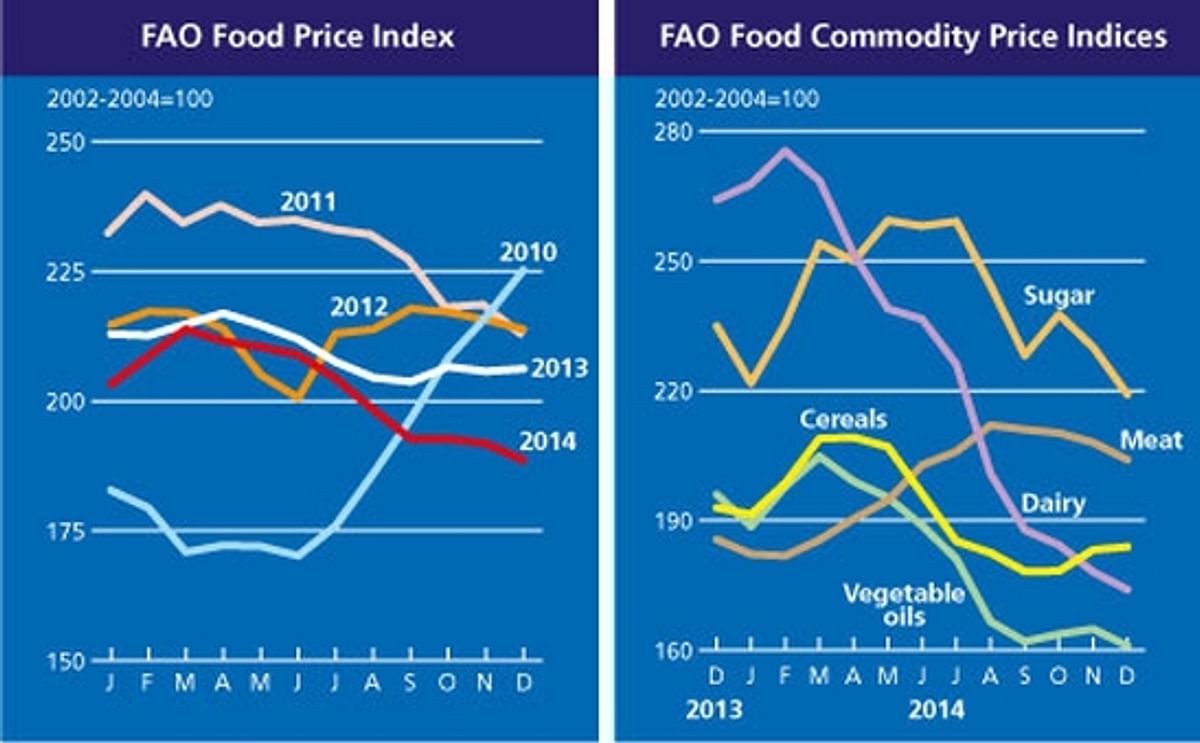The FAO Food Price Index averaged 188.6 points in December 2014, down 3.2 points (1.7 percent) from November. The Index, which had been in a downward trend between March and September, remained fairly stable in October and November, before falling again in December.
Over the full year, the Index averaged 202 points, down 3.7 percent from 2013, with the sharpest year-on-year falls registered by cereals (12.5 percent), followed by dairy products (7.7 percent), oils (6.2 percent) and sugar (3.8 percent). Only the FAO Meat Price Index recorded an increase, advancing by 8.1 percent compared to 2013.
The FAO Cereal Price Index averaged 183.9 points in December, up slightly (0.4 percent) from November, primarily driven by a rise in wheat prices which more than offset a decline in rice quotations. Worries about the possible introduction of restrictive export measures by the Russian Federation pushed up wheat prices although a general strengthening of the US dollar and weak trade activity limited the increase. Rice prices fell markedly, reflecting a combination of abundant export supplies and sluggish import demand. In 2014, the FAO Cereal Price Index averaged 192 points, down 12.5 percent from 2013, as international prices of all cereals subsided, driven by record production and large stocks.
The FAO Vegetable Oil Price Index averaged 161 points in December, down 4 points (or 2.4 percent) from November. The drop in the index mainly reflects developments in the palm oil market, as the recent slump in crude oil prices depressed demand for palm oil as a biodiesel feedstock, causing international palm oil values to weaken. Only towards the end of December prices recovered, as excessive rains slowed down harvesting and crushing operations in Malaysia amid higher than expected global export demand. For 2014 as a whole, the Index averaged 181 points, down 6 percent from 2013, with palm oil, the vegetable oil with the highest weight in the Index, falling to a 5-year low.
The FAO Dairy Price Index averaged 174 points in December, down 4.1 points (2.3 percent) from November. Abundant export supplies continued to weigh on international prices in December. Over 2014, prices for international milk products averaged 224.2 points, down 7.7 percent from 2013. This fall has stemmed from increased export availability and a reduction in the pace of purchases by some of the leading importers, especially China and the Russian Federation. The decline in prices was most pronounced for milk powders, followed by butter and cheese.
The FAO Meat Price Index averaged 204 points in December, a reduction of 4 points (1.9 percent) from November, reflecting weaker quotations for bovine and ovine meat from Oceania and lower pigmeat prices from Europe. The stronger US dollar and a growth in export availability were among the main factors influencing prices. However, meat products were the only commodity group within the FAO Food Price Index to register an increase during 2014, up 8.1 percent from 2013.
The FAO Sugar Price Index averaged 219 points in December, down 11 points (4.8 percent) from November 2014. Ample supplies in major sugar producing countries, including Brazil, the world’s largest producer and exporter, and falling crude oil prices, which reduce the volume of sugar crops being converted into ethanol, weighed on international sugar quotations in December. Sugar prices were mostly under downward pressure over 2014, averaging 9.6 points, or 3.8 percent, lower than in 2013.
The FAO Food Price Index fell in December

Like to receive news like this by email? Join and Subscribe!
Get the latest potato industry news straight to your WhatsApp. Join the PotatoPro WhatsApp Community!
Sponsored Content
Sponsored Content
Sponsored Content
Sponsored Content








